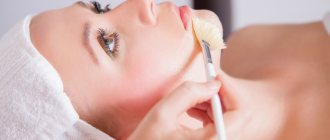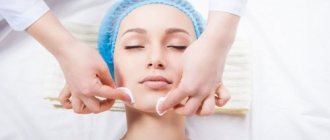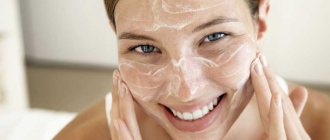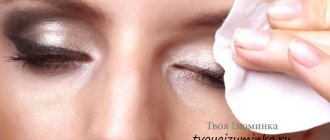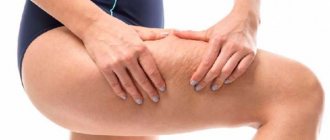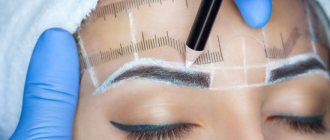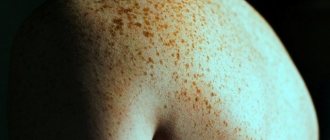As a rule, upon receiving the good news of a diagnosed pregnancy, for most working women, nothing much changes in their professional activities. Unless you have to make sure that you don’t snack on the go, but have a full lunch, walk more, be less nervous, and don’t forget about rest. But there are many features in the work of a cosmetologist - these are numerous close contacts with people, and the drugs that you have to deal with, and many other factors. estet-portal.com believes that the cosmetologist will have to reconsider some working habits during pregnancy.
Prevention of infectious diseases during pregnancy
The work of a cosmetologist involves close and numerous contacts with people. Moreover, we are talking not only about communication, but also about contact with the skin of patients, some physiological fluids, and primarily with blood. Therefore, during pregnancy, a cosmetologist must adhere very carefully to the following rules.
• Carry out any procedures only with gloves. It is no secret that doctors often neglect this safety requirement. But during pregnancy it’s time to remember about it. Direct contact with the patient's skin or blood exposes the physician to the risk of infection. Therefore, dermabrasion, chemical peeling, injection of drugs (even once and with a disposable syringe), hardware procedures that damage the skin - all these are high-risk factors that require the use of gloves by the doctor.
• Wear a disposable mask. Of course, a client with obvious signs of a cold or viral illness should be offered to reschedule the procedure. Such a proposal is not only motivated by the safety of the doctor, but is also justified from the point of view of the effectiveness of the procedure. But sometimes it is impossible to transfer, or the client does not have clearly defined signs of infection. To reduce the risk of getting sick, the doctor must wear a disposable mask while working that completely covers the respiratory tract. If the procedure is long, the mask is changed every hour. During the flu season, the office should be ventilated between patient visits and, if possible, turn on a quartz lamp.
One of the most dangerous infections for a pregnant woman is rubella. If the doctor is not immune to it, you should inform your patients and the clinic administration about this so that, if necessary, management can find a replacement.
Dermatologist-cosmetologist Elizaveta Alekseevna Gintovt talks about the possibility of cosmetology during pregnancy and lactation:
During pregnancy, unpleasant physiological changes can occur such as hyperpigmentation, stretch marks of pregnancy, pregnancy acne, increased dry skin, deterioration of hair condition and vascular changes.
Hyperpigmentation is a physiological change in the skin that is very common in women during pregnancy and lactation. The main reason for this problem is an increase in the level of melanocyte-stimulating hormones, as well as an increase in the sensitivity of certain areas of the skin to sex hormones - estrogens and progesterones. In such patients, we often observe chloasma - increased pigmentation of limited areas of the skin. Pigmented spots are located on the forehead, cheeks, temples, very often above the upper lip; there may also be pigmentation of the midline of the abdomen, parapapillary zones and external genitalia. Brunettes are more often exposed to these manifestations.
Unfortunately, cosmetology can do little during pregnancy: it is only possible to slightly reduce the level of skin sensitivity by recommending the use of sunscreen. Sometimes we prescribe a very light glycolic peel with a concentration of no more than 5-10% and a neutral pH. We prescribe home care creams with a small concentration of glycolic acids. After lactation, we orient women to fractional photothermolysis using a Fraxel-type device. I love Fraxel - it works delicately, the rehabilitation is quite gentle, but the results are excellent. The procedure can be done only after pregnancy and lactation. If only because the procedure is very painful, and this can tone the uterus. A woman needs to be protected during this period so that she experiences only positive emotions, while any negativity can, unfortunately, have a bad effect on the course of pregnancy. In addition, before the procedure, a fairly active anesthetic cream is applied and, as a rule, the procedure affects quite large areas. The application of these creams is also unknown how it can affect pregnancy and lactation; such studies have not been conducted.
Thus, during pregnancy, cosmetologists can only slightly alleviate a woman’s condition with the help of gentle home care, and after the end of lactation, begin the Fraxel procedure.
This is not a public offer! There are contraindications. Before use, consultation with a specialist is required.
The next problem is hair . During pregnancy, the period of active hair growth called anagen increases: hair grows all the time. The telogen stage—the resting or resting period of the hair—is shortened. During pregnancy, we can see increased hair growth not only in the scalp area, but it also happens that hair appears on the face, above the upper lip, and hair growth on the legs increases slightly. After childbirth, this process normalizes.
During normal pregnancy, hair does not fall out. They become worse during lactation, because most of the hair follicles enter the telogen stage after childbirth. Three months after childbirth, increased hair loss on the head is observed, the so-called physiological telogen effluvium, and we cannot influence this. Then, if the process is prolonged, you can prescribe mesotherapy and good vitamins, but it is practically impossible to influence the period itself.
Any injection procedures during pregnancy and lactation are prohibited. The effect of certain substances on the course of pregnancy is unknown. The instructions for even the most common pharmaceutical drugs say “except during pregnancy and lactation.” Even hyaluronic acid, so beloved by patients, is prohibited.
During pregnancy, we can offer a very small number of hardware procedures . We have Lift 6, Endermology Facial (LPG) and Body Oxyjet - non-injection oxygen injection.
This is not a public offer! There are contraindications. Before use, consultation with a specialist is required.
Pregnancy acne is a very serious problem that can occur in patients who have never experienced acne before. For most young women, the rash gets worse during pregnancy. The most problematic periods are the early stages: 4-8 weeks, and then from 13 to 20 weeks. This is due to the fact that the production of testosterone and androstendyle increases, which are direct stimulators of sebum production. The fact that before pregnancy, patients very often take oral contraceptives, the cancellation of which also affects the increase in the number of rashes, also plays a role in the deterioration of the skin condition.
As for acne, when planning pregnancy you should strictly avoid taking retinoids internally, and during pregnancy externally. We are talking in particular about systemic retinoids containing isotretionine, for example, Roaccutane. Such drugs can cause serious complications - teratogenicity and embryotoxicity. If pregnancy occurs, you should also stop applying Differin, Isotrexin, retinoic ointment and others containing retinoids.
During lactation, the same anti-acne medications can be used as during pregnancy. We can only prescribe something that does not penetrate the skin and is not detected in the systemic bloodstream: Baziron gel, Dalatsin gel, Zerkalin solution. And drugs containing erythromycin: “Zinerit”, erythromycin ointment. And also well-known preparations containing azelaic acid: Skinoren gel and cream, Azelik gel. Preparations containing salicylic alcohol should not be used during pregnancy and lactation.
What to do? The main goal is to prevent deterioration of the skin condition, prevent the appearance of scars and improve the psychological state of the patient. We may prescribe a superficial chemical peel with low concentrations of glycolic acid or alpha hydroxy acids. Mechanical peeling – brossage and microdermabrasion. Cosmetics and cosmetic camouflage. If external treatment still does not have an effect, and the woman is prone to scarring, then we prescribe systemic antibacterial therapy under the strict supervision of a doctor for a short period of time. The safest antibiotic that can be used during pregnancy is erythromycin. It can only be taken from the second trimester and for a short period of time. I prescribe for no more than 7-10 days, only for severe forms of acne and a high probability of scarring. In the last trimester of pregnancy and during feeding, the use of antibiotics effective in the treatment of acne (especially tetracyclines) is strictly prohibited, since irreversible changes in the development of teeth in the fetus are possible. In addition, the drug is a photosensitizer, that is, it increases skin pigmentation. Clindamycin externally and Erythromycin internally should not be used during breastfeeding.
This is not a public offer! There are contraindications. Before use, consultation with a specialist is required.
vascular changes also occur during pregnancy . This may be rosacea and/or the appearance of spider veins, most often in the legs. We prescribe external treatment: creams that strengthen the vascular network. And after pregnancy, it will be possible to perform laser removal of blood vessels. Even during lactation, single vessels can be removed with a laser; phototherapy can also be very carefully carried out on small areas in order to strengthen the walls of blood vessels. A single hemangioma can be removed, but if there are a large number of hemangiomas, then you need to wait until the end of lactation.
for the occurrence of stretch marks . For example, increased adrenal function, mechanical factors, genetic predisposition. I would also like to note that long-term use of steroid hormones (oral contraceptives) before pregnancy also increases the risk of stretch marks. In general, if the predisposition to the formation of stretch marks is very high, then you need to be more careful with oral contraceptives. This is not in the instructions, but in the specialized literature, long-term use of OCs is noted as one of the mechanisms for the formation of stretch marks. This has been proven, but the instructions do not say that oral contraceptives should not be used for a long time. During pregnancy, we cannot use anything other than creams. Pharmacy creams and specialized creams for pregnant skin are quite effective. Of course, they will not solve the problem completely, but they will strengthen the skin.
After the end of pregnancy and lactation, fractional exposure and mesotherapy to eliminate stretch marks You need to start fighting stretch marks the sooner the better, since in a few years it will be much more difficult.
increases in women with dry skin . In this case, we use creams, serums, glycolic peels, and nourishing masks.
The figure problems that arise after pregnancy are a flabby stomach, sagging inner surface of the arms and thighs, as well as ptosis of the mammary glands. It will not be possible to prevent them - during pregnancy we can only prescribe isothermal wraps on the legs, pressoterayu and endermology on the lower extremities (if possible, because this procedure is performed in a prone position) in order to slightly reduce the formation of edema and heaviness in the legs. During lactation, Beautytech therapy can be prescribed to the abdominal area, which gives excellent results (the abdomen contracts well) and has a good effect on stretch marks. And after the end of lactation, you can prescribe procedures using the Titan apparatus, which is also good at removing abdominal sagging, especially in the early stages.
But even if you follow a strict diet, due to changes in hormonal levels, the skin can greatly lose tone, especially in the abdominal area. In this case, only plastic surgery can help.
Also read:
“Appearance problems through the eyes of a therapist, endocrinologist, hematologist”
“Oily skin and acne after 30 years”
"Body skin problems"
"Skin Aging: New Data"
"Varicose veins and its treatment"
This is not a public offer! There are contraindications. Before use, consultation with a specialist is required.
Correction of working conditions for a cosmetologist during pregnancy
In the first trimester, you can continue to work as usual if your health does not cause concern. It is important not to forget to sometimes pause between procedures to eat and rest. In the second trimester, it is advisable to plan your work schedule so that between procedures there are at least 15 minutes left for rest, and take 30-40 minutes once a day to eat quietly, walk or lie down. Often cosmetologists work almost until the birth, but in the third trimester it is necessary to allocate time during the working day for two breaks and try not to work more than 8 hours a day.
Most cosmetologists work while sitting, and during pregnancy it is important to have a work chair that is height adjustable, has a comfortable backrest and is fairly stable. When working while standing, choose comfortable shoes and wear compression stockings to support the blood vessels in your legs.
It is important for a pregnant cosmetologist to minimize stress at work. In case of conflicts with patients, do not hesitate to ask the administration for help.
In order to minimize the risk of developing conflict situations, try to explain to patients in particular detail possible side effects after procedures, obtain signed informed consent from them, and carefully maintain all documentation.
Hair care
There is an unusually persistent myth that pregnant women should not cut or dye their hair.
Where it came from is now difficult to understand, but nevertheless, in the antenatal clinic you will definitely meet several expectant mothers with noticeably grown hair roots and a haircut that has lost all shape. There is no scientific evidence that cutting or dyeing hair with modern gentle hair dyes can harm a pregnant woman or unborn child. Therefore, forget about grandma’s fears and feel free to go to the beauty salon! The only caveat is that don’t forget that after the birth of your baby, you most likely won’t have time for a hairdresser in the first months, so closer to the birth, get a haircut that will be easy to care for when you’re short on time.
Hair
As for hair coloring, there is no harm to the expectant mother’s curls, but the skin becomes much more sensitive during pregnancy, and this makes the process uncomfortable. Dyeing your hair is not prohibited, but you should avoid aggressive dyes and tonics.
Monitor the composition of the products, the condition of your hair, and the master’s compliance with technology and hygiene during the dyeing process. Perms, extensions, thermal straightening and hair treatment with ampoules should be abandoned for a while. Remember that all nutrients go to meet the needs of the fetus, and the mother’s needs are met according to the residual principle: after childbirth, the quality of your hair may noticeably suffer.
Hair care
Masks for pregnant women: what and how to use
There is a list of products that are indicated for use in maternity masks. They will help solve typical skin problems without harming the fetus:
1. Lemon. Rubbing the skin with lemon juice is recommended to lighten it, fight pigmentation, and also to dry out pimples and remove blemishes.
2. Potatoes. Fresh potato gruel is an excellent moisturizer, suitable for refreshing sensitive skin and getting rid of age spots.
3. Cucumber – well moisturizes and whitens, gentle.
4. Cottage cheese - a mask with the addition of egg yolk whitens the skin, and the protein will help fight acne.
5. Yeast - will refresh the appearance, remove excess fat, flaking, redness, nourish and moisturize.
Don't count on quick results. However, if you make masks constantly, several times a week for a month, the results will be obvious.
What cosmetic procedures are allowed for pregnant women?
During gestation, the development of itching and dryness of the skin or, conversely, excess oiliness, increased skin sensitivity, the appearance of acne, swelling, marks of scratching, spots of “pregnancy” (spots of hyperpigmentation, or chloasma), changes in hair shade and loss of shine are possible. and elasticity, etc. All these negative changes often upset the woman and negatively affect the course of pregnancy.
They can be reduced or eliminated using certain cosmetic products and methods. In addition, very often all techniques used independently or, especially, in a salon, help eliminate negative emotions, significantly improve mood and create a favorable psychological background.
However, unfortunately, not all cosmetic procedures can be used. It is advisable to coordinate their choice with a gynecologist, with whom the woman is constantly monitored, and an experienced cosmetologist. In the literature, there are no specific recommendations for each manipulation, but conditionally (in terms of application to pregnant women) they distinguish:
- Methods and drugs with absolute contraindications.
- Methods with relative contraindications.
- Procedures that have no contraindications.
Video: Cosmetology during pregnancy
Absolutely contraindicated:
Solarium
Visiting a solarium, which not only contributes to the appearance of hyperpigmentation spots, but also affects the function of the endocrine and cardiovascular systems, and also significantly increases the risk of cancer during pregnancy.
Massage and thermal effects
Intensive general or over a large area of the body manual massage, cold (cryotherapy) or thermal procedures, which include visiting a bath or sauna, hot or thermal (mud, chocolate, seaweed) general wraps, since they can lead to increased activity of the myometrium with subsequent miscarriage or premature birth, accompanied by severe bleeding.
Hardware methods
Active physiotherapeutic and cosmetological hardware methods based on ultrasound, electromagnetic, photo and laser types of radiation, microcurrent therapy, hardware types of massage, especially LPG.
Epilation
Laser, photo, electro- or ultrasound hair removal, as well as the use of depilatory creams, the chemical components of which can penetrate through small damaged vessels into the woman’s general bloodstream and then to the fetus.
Peeling and disincrustation
Galvanic disincrustation, as well as peeling procedures (especially medium and deep peeling) on the face and body using laser, salicylic, trichloroacetic, retinoic acids, alpha and beta hydroxy acids and, especially, phenol peeling. In addition to the fact that these types of peeling cause painful reactions, increase sensitivity to ultraviolet rays with the subsequent formation of hyperpigmentation spots, they can cause a pronounced inflammatory process with subsequent infection of the treated skin and the penetration of infection and toxic chemicals through the wound surface into the bloodstream of the woman and fetus.
Injection rejuvenation
Injection procedures - mesotherapy and biorevitalization with the use of hormonal or placental drugs, contouring, Botox. Their use is associated with an increased reaction to pain during pregnancy, with altered sensitivity to some biorevitalizants and with the risk of developing severe allergic reactions, as well as with the lack of serious studies on the long-term effects of some drugs, for example, botulinum toxin preparations, on pregnant women and the fetus. Read more about the advisability of using Botox during pregnancy.
The use of aromatic oils is also prohibited, since their effect is often unpredictable.
Procedures with relative contraindications and requiring a doctor’s permission:
- low-intensity massage of the face, head, back, neck and limbs. You can use special massage brushes for pregnant women, designed for bathing. Massage helps to normalize the function of the nervous system, reduce swelling of the face and limbs, muscle and psycho-emotional tension, and eliminate the feeling of fatigue;
- mechanical peeling, but very careful;
- mesotherapy using hyaluronic acid and vitamin cocktails;
- depilation using wax, sugar;
- nail extensions. The chemicals used, especially methacrylate, have a pungent odor and are toxic substances. Therefore, you should be careful when applying nail extensions;
- tattooing and whitening procedures based on retinol;
- perm, hair dyeing, especially in the first trimester of pregnancy and especially with dyes containing ammonia.
During pregnancy, relaxing and spa procedures are allowed and even recommended (but subject to the normal temperature of the environment used), as well as techniques characterized by a “mild” effect and helping to improve the physical and psycho-emotional state. It is advisable to carry out a light manual massage of the legs in the absence of varicose veins. This massage helps to improve the outflow of fluid and remove toxic metabolic products along with it not only from the tissues of the lower extremities, but also from the entire body.
Body
Massage is a very controversial issue when it comes to pregnant women. You can massage the collar area and neck without fear, but if you massage the legs, there is a risk of dispersing blood and lymph from the extremities to the pelvis and groin, which is undesirable. Vacuum and mechanical massage, sauna and steam bath are not recommended for mothers.
Treatments using essential oils during pregnancy should be avoided. There are several reasons for this: a pregnant woman may perceive the previously pleasant smell of the oil differently, aromatic oils tend to affect the nervous system and mood, and some of them can even cause uterine tone and early labor.
Stretch marks that inevitably appear on the body of an expectant mother are a natural, but very unpleasant phenomenon. Tight skin itches, darkens, and becomes covered with striae. The process can be prevented only if special creams and lotions are used from an early stage. Stretch marks do not disappear completely after childbirth - they can only lighten over time.
Some clinics will offer you transdermal mesotherapy, for which your position is not a contraindication. In the process, hyaluronic acid, vitamins and microelements are injected under the skin of the abdomen, but we are not talking about injections, but about a special apparatus with oxygen under pressure.
All manipulations should be discussed in advance with a gynecologist.
Body care
Salon treatments
Many people forget the way to a cosmetologist as soon as they see two lines on the test. This is a completely unnecessary sacrifice! Yes, there are certain procedures that are not recommended during pregnancy, but most skincare programs are quite affordable and will help maintain your beauty during this wonderful period. Just remember to notify the cosmetologist about your interesting situation, and the doctor will offer you suitable care.
It would also be a good idea to consult with the obstetrician-gynecologist who is caring for your pregnancy.
It is forbidden
- Procedures associated with a sharp change in temperature: cryosauna, hot wrap, etc.
- Hardware stimulating procedures can provoke contraction of the uterine muscles.
- Laser procedures and photorejuvenation.
- Injection techniques.
Massage
There is a widespread belief that pregnant women should not receive massage. In fact, it is possible, but only if the massage therapist has the appropriate qualifications. Regular massage can cause undesirable consequences. But a special massage for pregnant women, on the contrary, will significantly improve your well-being and condition. During this difficult period, when increasing weight, swelling, increased stress on the back and legs can cause many unpleasant moments, an experienced massage therapist will be of great help.
The main thing to remember is to be less nervous, don’t let meaningless restrictions poison your life and enjoy every moment of your magical state!
What's really not allowed?
Hardware cosmetology
Cosmetic devices that operate through current, ultraviolet light, laser, and phototherapy are not recommended. Active chemical peeling is also not allowed. Procedures that require local anesthesia will have to be replaced or completely abandoned. So, for example, in order to cure a tooth, you will have to endure some pain .
All this is based on the close interaction between the mother and child. Anesthetics and other cosmetic chemicals can penetrate the placenta to the fetus, causing damage to the baby's organs and systems.
Due to hormonal changes, the sensitivity and susceptibility of the skin changes. Therefore, perming and dyeing hair can cause allergic reactions in the mother (the dye will in any case come into contact with the scalp).
Solarium
Ultraviolet radiation, which affects your entire body, harms not only the baby, but also you. Due to endocrine shifts, the skin is prone to hyperpigmentation . UV increases the risk of developing cancer.
Thermal treatments
Sauna, steam bath, hammam, cryotherapy are contraindicated. With a sharp change in ambient temperature, a change in the tone of blood vessels and myometrium occurs. As a result, spontaneous miscarriage or bleeding may begin.
What cosmetic procedures can be done for pregnant and nursing mothers?
What exactly are these restrictions associated with?
- Firstly, with changes in the tissues themselves: skin, hair, nails. During pregnancy, they become looser, hypersensitive, and thinner. This is a natural process associated with gestation.
- Secondly, the pain threshold increases and procedures that previously did not cause much discomfort - hair removal of the legs, for example, turn into extremely painful ones. Against the background of pain, inflammation easily develops, which should not be allowed. In addition, sensitivity to odors also appears, which makes many cosmetic procedures impossible.
- Thirdly, the expansion of blood and lymphatic vessels significantly increases the risk of injury and bleeding.
- Fourthly, many ordinary phenomena turn into threats. Vibration, electromagnetic impulses, physical activity, even music with an abundance of too low or too high frequencies can provoke an increase in the tone of the uterus, which leads to miscarriage.
The severity of certain restrictions is related to the condition of the expectant or nursing mother, but they cannot be ignored. On the other hand, cosmetic procedures for which the listed factors are invalid are quite feasible.
The video below talks about cosmetic procedures during pregnancy:
Allowed
All cosmetic procedures can be divided into acceptable, relatively acceptable and prohibited. But in any case, before going to a beauty salon, you should consult with a leading doctor, and also repeat all tests for an allergic reaction. With hormonal changes, indicators can change noticeably.
Pregnant and nursing mothers are allowed to resort to the following procedures:
- light lymphatic drainage facial massage - it helps improve skin tone and remove swelling, which affects many expectant mothers;
- very soft superficial peeling – with fruit acids, enzymatic. At home, it is preferable to use scrubs with neutral abrasive particles: brewed ground coffee, salt, sugar;
- moisturizing masks for sensitive skin - as a rule, during pregnancy the water balance of the skin is disturbed. For the same reasons, it is recommended to switch to moisturizing creams and thermal water;
- manicure and pedicure are completely safe procedures. The only limitation here may be the smell of varnish or solvent. If you become sensitive to them, you should look for other means;
- the use of oils as creams and masks is not only allowed, but also strongly recommended. Stretch marks are almost inevitable during pregnancy. In order to at least to some extent prevent the appearance of stretch marks, it is advisable to lubricate the skin with almond, linseed, and olive oil. Moreover, this recommendation is relevant for both dry and oily skin;
- massage of the head, back, neck, arms and legs . Low-intensity procedures are selected, aimed at relaxing muscles and relieving swelling. The massage therapist must be warned about pregnancy, since many techniques are prohibited in this state. Massage for a nursing mother has fewer restrictions.
Procedures with relative contraindications
This category includes procedures that can be performed at a certain stage of pregnancy or in the absence of one or another complication. And in such cases, consultation with a doctor is necessary.
- Hair removal as such has no restrictions. But it is allowed to be performed only with a low pain threshold. The point is not even that the woman herself experiences much more severe pain than she should, but that the pain syndrome increases the tone of the uterus, and this is dangerous. In addition, due to loose skin and dilation of blood vessels, the risk of injury increases;
- depilation - with salt and sugar, is not available to everyone for the same reasons. Nursing mothers can use depilation without restrictions;
- mechanical superficial peeling – dilation of blood vessels, fragility of the walls increases the risk of injury. For short periods of time, this factor is not so great and the procedure is allowed;
- hair coloring is permitted provided that an ammonia-free product is used and the pregnant or lactating woman is not allergic to its smell;
- perm - in the first trimester is extremely undesirable due to an unexpected reaction to the odors of the substances used. In 2 and 3 it is allowed if gentle means are used. It is worth considering that the hair at this moment is very weakened and any radical procedures affect the condition of the curls much more noticeably. If a woman is already losing her hair, she should refrain from curling and coloring. During the feeding period, the restrictions are the same;
- nail extensions are permitted or allowed for the same reasons. The procedure itself does not pose any danger, but chemicals with a pungent odor are used. If a woman is not sensitive to them, then it is carried out only in a well-ventilated area;
- tattooing – the pain of the procedures increases noticeably. In addition, due to the looseness of the skin and intense lymph flow, coloring pigments are destroyed much faster, “spread”, deforming the applied pattern, so that the result is completely unattractive;
- mesotherapy based on hyaluronic acid is allowed if the woman does not have an excessive painful reaction. But here it is worth considering one more feature: artificially introduced substances during pregnancy and lactation are consumed much faster, so the result of mesotherapy does not last long;
- dry air sauna – allowed according to individual indications. In any case, a bath is an excess of heat, and it is not always useful. It is not for nothing that our ancestors got rid of unwanted children by visiting a bathhouse, so this procedure is carried out only after the doctor’s permission.
